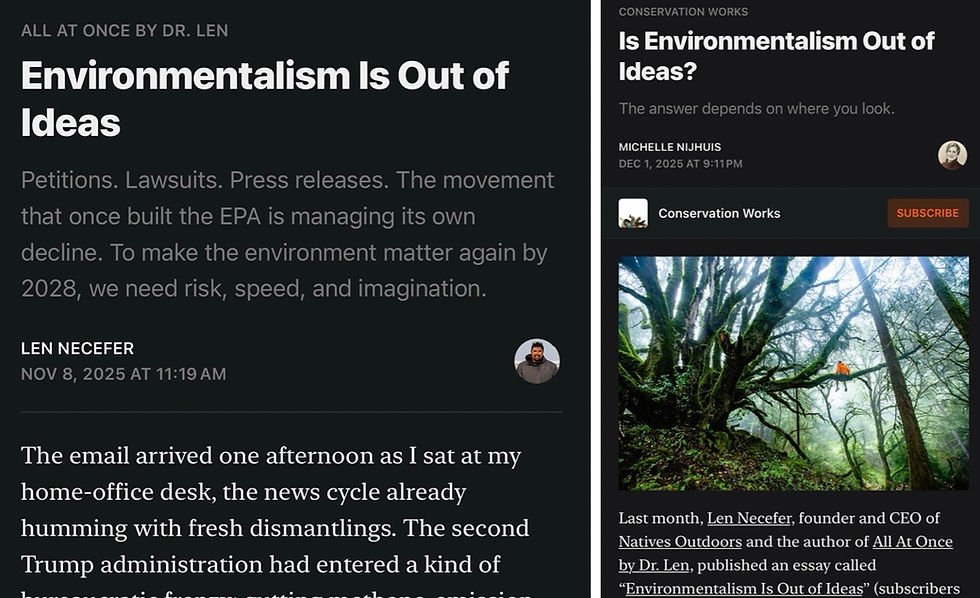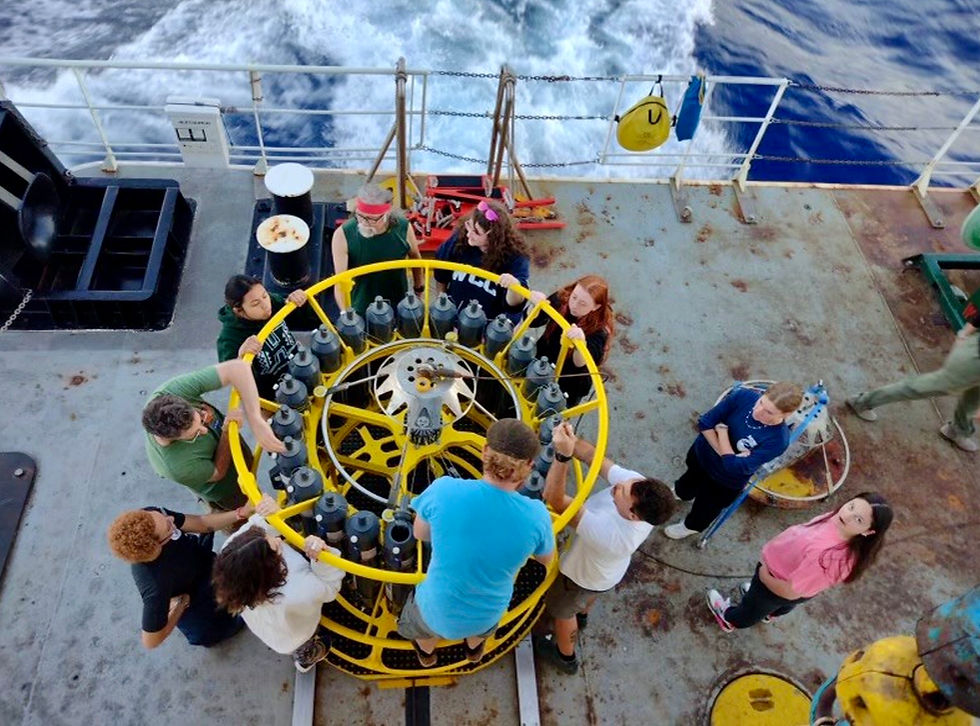After the Bleaching
- Ocean Hoptimism

- Oct 14
- 5 min read
Updated: Oct 14
Speaking Honestly About Hope in the Age of Dying Reefs
The maps are lit red again. The ocean’s fever shows no sign of breaking. According to a sweeping new analysis by 160 scientists, coral reefs, the rainforests of the sea, have been pushed beyond what they can cope with. Eighty-four percent of reefs across 83 countries are bleaching. For the first time, we are watching a global ecosystem approach functional collapse in real time.
We sat with this report for a long while before writing. For those of us who have measured our lives in reef time, in surveys and field seasons, in bleaching events and fragile rebounds, this one lands differently. It’s the gut punch we’ve all known was coming, the other shoe finally dropping. Knowing doesn’t make the acknowledgment any easier.
If we say resilience in this moment, are we lying?
If we speak of hope, are we selling a sedative or offering a strategy?
These questions sit at the heart of Ocean Hoptimism, a movement that gathers people once a month not to escape the bad news, but to metabolize it together. To face it fully, pint in hand and heart open, and then ask: Now what?

A Working Thesis
Hope without truth is propaganda.
Truth without hope is paralysis.
Between those poles lies the narrow, necessary ground where honest hope lives, the kind we’ve had to practice our entire careers. The kind that keeps its eyes open long enough to notice what still resists beneath the heat.
To speak of hope now is not to deny collapse; it is to insist on agency amid it. We can name what is dying without surrendering to the idea that everything is dead. We can mourn reefs that will not recover and still fight for the fragments that might.
“Hope with teeth” is not a comfort mantra; it’s a discipline of clear seeing and sustained action. A kind of emotional triage. We grieve what’s gone, stabilize what’s wounded, and mobilize everyone who still has a pulse. Because the opposite of hope isn’t hopelessness, it’s indifference. And indifference is how tipping points become tombstones.
Naming the New Reality

We’ve all watched the thermometer rise. The world has already warmed 1.3 °C since the Industrial Revolution, and each fraction of a degree multiplies the odds of crossing what the IPCC calls tipping points—thresholds beyond which change becomes self-propelling and often irreversible.
Reefs are the first of these thresholds to crack. They buffer coasts, feed half a billion people, and generate $10 trillion in planetary life support systems. Yet they are unraveling before our eyes. The question before us is not whether we can “save” reefs in the nostalgic sense, but whether we can hold the line on collapse long enough for survivors to seed what comes next.
This is the era of triage, not restoration; of stewardship without certainty. And those of us who have worked underwater know: it demands moral clarity as much as scientific skill.
Refuse the Two Comfortable Lies
Every crisis breeds its lullabies, stories that help us sleep while the sea keeps rising. Some whisper that nature will self-correct; others that nothing we do matters. Both are comforting, and both are false.
What the moment demands is discernment: to hold two truths in tension: that much has already been lost, and that much still depends on what we do next.
1. Panglossian Resilience
“Reefs will bounce back if we just reduce local stress.”
Sometimes they do. We’ve seen corals recover from storms or mild bleaching. But at current heat levels, systemic rebound is fiction. Local action (cleaner water, better management) matters profoundly, yet it cannot substitute for cutting emissions. Without cooling the ocean, we’re rearranging deck chairs on a sinking ship.
This lie comforts funders and policymakers who want progress without confrontation. But confusing temporary reprieve with recovery mistakes survival reflex for salvation.
2. Performative Doom
“It’s over, nothing matters.”
We’ve heard this too, often from people who should know better. This lie wears tragedy as sophistication. It flatters us with the illusion that recognizing collapse absolves us from acting. But even in decline, there are gradients of loss and pockets of endurance. There are reefs that still breathe, communities that still depend on them, and children who will judge whether we fought for one more decade of livable coastlines.
Despair is a privilege of those with exits. For everyone else, hope, practiced as stubborn persistence, is survival strategy.
What Hope Really Means
Hope is dishonest if it anesthetizes; moral if it mobilizes.
It names the emergency, honors grief, and then acts with precision.
That means working where leverage remains:
Hold the line on heat—every tenth of a degree matters.
Protect the survivors—fund research, refugia, and assisted adaptation where it still buys time.
Cushion human fallout—invest in safety nets and cultural continuity for reef-dependent communities.
This is not optimism; it is obligation. Hope is the daily discipline of refusing to look away.
When the Federal Government Won't Help
In an era where parts of the U.S. government dismiss climate science and environmental law is being gutted, we need to shift the battlefield. If Washington goes “post-truth,” we change terrain.
State and Local Shields — California, Hawai‘i, and the territories can lead where federal policy retreats, enacting reef-safe standards, runoff controls, and litigation against preemption.
Courts and Administrative Law — Defend existing protected areas and environmental legislation when rollbacks threaten the scientific baseline.
Supply Chain Governance — Reef bleaching risk is financial risk. Make it a disclosure requirement for tourism, fisheries, and coastal real estate. Align reinsurer pressure with reef-safe behavior.
Investor and Liability Levers — Treat bleaching risk as financial risk; force disclosure and accountability.
Culture as Infrastructure — Narrative is a system lever. Ocean Hoptimism isn’t ornamental. It’s civic hardware for belonging and stamina in a demoralized age.
The Role of Ocean Hoptimism

We don’t run labs or patrol reefs. We build social circuitry. Our work is to convene, connect, and catalyze. To give weary ocean professionals and curious newcomers a place to breathe, learn, and act.
Each month an expert brings a reason for ocean hope: a discovery, a legal win, a glimpse of adaptation. We absorb it together, laugh, sometimes cry, and leave with micro-actions: call your representative, sign a petition, join a cleanup, share one photo that rekindles care.
That is how movements propagate: one conversation at a time, one pint at a time, one act of defiant, resilient optimism at a time.
Reclaiming "Resilience"
Resilience is not the refusal to feel pain; it’s the refusal to let pain set the horizon. When reefs bleach, when laws weaken, when funding vanishes, resilience means gathering anyway, telling the truth aloud and plotting the next right thing together.
As corals build reefs millimeter by millimeter, we build belonging through slow, stubborn construction in an age of rapid loss. Each story, each event, is another fragment fused to the whole.
A Vow, Not a Mood
“If we wait to cross tipping points before we act, it will be too late.” — COP30 scientists
They are right. But waiting has never been our way.
To speak of hope now is not to deny collapse; it is to refuse surrender. It is to stand inside the grief and still reach for the lever that turns compassion into movement.
The reefs may never look the same again. But how we respond, numb or courageous, will decide whether our species deserves to endure beside them.
So we gather. We learn. We act. We pour another pint, raise another toast, and keep building hope with teeth—one living fragment at a time.



Comments